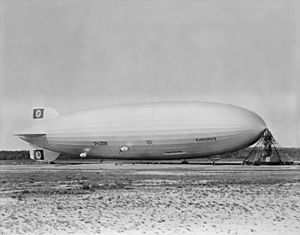LZ 129 Hindenburg facts for kids
The LZ 129 Hindenburg was a giant German airship built in 1936. It was named after Paul von Hindenburg, an important German leader. This type of airship is called a Zeppelin. The Hindenburg, along with another Zeppelin called LZ 130 Graf Zeppelin, was the biggest airship in the world when it was built.
The Zeppelin became very famous and got a lot of attention. A famous boxer named Max Schmeling flew on it back to Germany after winning a big fight in the United States. The Hindenburg also flew over the opening ceremony of the 1936 Summer Olympics in Berlin. All this attention was part of the Zeppelin company's plan to offer flights across the Atlantic Ocean.
Contents
Building the Hindenburg
The Zeppelin Company started planning a new airship in 1929. They wanted to build a ship that was about 237 meters (778 feet) long. This new airship would carry a lot of hydrogen gas.
They began making parts for the Hindenburg in 1931. But the actual building of the airship didn't start until March 1932.
The Hindenburg had a strong, light metal frame. Inside, it had 16 large bags filled with gas. The outside of the airship was made of cotton fabric. This fabric was treated with special materials. These materials helped protect the gas bags inside. They kept the bags safe from sunlight and heat.
The inside of the Hindenburg was designed by Fritz August Breuhaus. He had also designed parts of trains, ocean ships, and even warships. The upper deck, called "A" Deck, had 25 small cabins for passengers. It also had large public rooms. There was a dining room on one side. On the other side were a lounge and a writing room. Paintings in the dining room showed the Graf Zeppelin airship's trips to South America. A map of the world was painted on the wall of the lounge. Both decks had long, slanted windows. Passengers were meant to spend most of their time in these public areas. The cabins were quite small.
The lower deck, called "B" Deck, had restrooms. It also had a dining area for the crew. There was even a special smoking lounge. This smoking room was sealed off to prevent any hydrogen gas from getting in. You could only enter it through a bar area. The bar worker would check passengers leaving the smoking room. They made sure no one was carrying a lit cigarette or pipe.
The Hindenburg Disaster
On May 6, 1937, the Hindenburg was trying to land in New Jersey. It had just completed a flight across the Atlantic Ocean. Suddenly, the airship caught fire. It burst into flames very quickly.
Sadly, 36 people died in the fire. Many others were also hurt. The Hindenburg was completely destroyed. The fire was caused by the burning of the hydrogen gas inside the airship. People still have different ideas about what exactly started the fire.
A radio announcer named Herbert Morrison was reporting the landing. When the fire started, he famously screamed, "Oh the humanity!" His words, along with photos and videos of the disaster, became known around the world.
Hindenburg in Movies and Music
- A picture of the burning Hindenburg was used on the cover of the rock band Led Zeppelin's first album in 1969.
- The movie The Hindenburg came out in 1975. It was inspired by the disaster. The movie suggested that someone might have caused the fire on purpose. The actual model of the Hindenburg used in the movie is now on display. You can see it at the National Air and Space Museum in Washington, D.C..
- In a 1977 episode of the TV show The Waltons, a character named John Boy Walton was sent to report on the Hindenburg's landing. He was very upset after seeing the disaster happen.
- The detective Charlie Chan was a passenger on the Hindenburg in the 1937 movie Charlie Chan at the Olympics.
Quick Facts
The Hindenburg was a truly massive airship.
- It was about 245 meters (804 feet) long. That's longer than two football fields!
- It was about 41.2 meters (135 feet) wide.
- It could carry 50 to 70 passengers.
- It had a crew of 40 to 61 people.
- The Hindenburg had four powerful Daimler-Benz DB 602 diesel engines. Each engine had 1,200 horsepower.
- It could cruise at a speed of about 122 kilometers per hour (76 miles per hour).
- Its top speed was around 135 kilometers per hour (85 miles per hour).
Images for kids
See also
 In Spanish: LZ 129 Hindenburg para niños
In Spanish: LZ 129 Hindenburg para niños
















